Input interpretation

phosphine
Chemical names and formulas
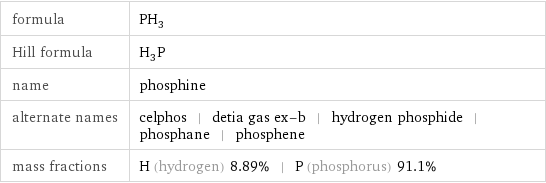
formula | PH_3 Hill formula | H_3P name | phosphine alternate names | celphos | detia gas ex-b | hydrogen phosphide | phosphane | phosphene mass fractions | H (hydrogen) 8.89% | P (phosphorus) 91.1%
Lewis structure
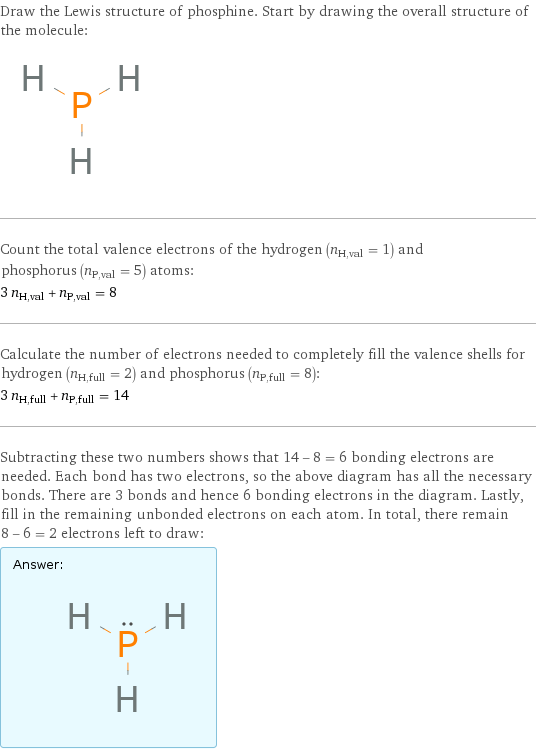
Draw the Lewis structure of phosphine. Start by drawing the overall structure of the molecule: Count the total valence electrons of the hydrogen (n_H, val = 1) and phosphorus (n_P, val = 5) atoms: 3 n_H, val + n_P, val = 8 Calculate the number of electrons needed to completely fill the valence shells for hydrogen (n_H, full = 2) and phosphorus (n_P, full = 8): 3 n_H, full + n_P, full = 14 Subtracting these two numbers shows that 14 - 8 = 6 bonding electrons are needed. Each bond has two electrons, so the above diagram has all the necessary bonds. There are 3 bonds and hence 6 bonding electrons in the diagram. Lastly, fill in the remaining unbonded electrons on each atom. In total, there remain 8 - 6 = 2 electrons left to draw: Answer: | |
3D structure

3D structure
Basic properties
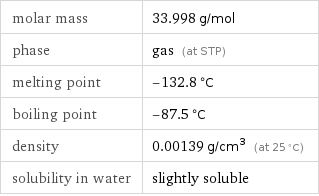
molar mass | 33.998 g/mol phase | gas (at STP) melting point | -132.8 °C boiling point | -87.5 °C density | 0.00139 g/cm^3 (at 25 °C) solubility in water | slightly soluble
Units

Gas properties (at STP)
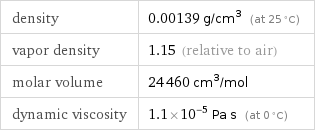
density | 0.00139 g/cm^3 (at 25 °C) vapor density | 1.15 (relative to air) molar volume | 24460 cm^3/mol dynamic viscosity | 1.1×10^-5 Pa s (at 0 °C)
Units

Thermodynamic properties

specific heat capacity c_p | gas | 0.6118 J/(g K) | gas | 10.912 J/(g K) | solid | 0.6236 J/(g K) | solid | 0.7 J/(g K) molar heat capacity c_p | gas | 20.8 J/(mol K) | gas | 371 J/(mol K) | solid | 21.2 J/(mol K) | solid | 23.8 J/(mol K) specific free energy of formation Δ_fG° | gas | 0.3971 kJ/g | gas | 8.239 kJ/g molar free energy of formation Δ_fG° | gas | 13.5 kJ/mol | gas | 280.1 kJ/mol specific heat of formation Δ_fH° | gas | 0.1588 kJ/g | gas | 9.309 kJ/g | solid | -1.156 kJ/g | solid | -0.5177 kJ/g | solid | 0 kJ/g molar heat of formation Δ_fH° | gas | 5.4 kJ/mol | gas | 316.5 kJ/mol | solid | -39.3 kJ/mol | solid | -17.6 kJ/mol | solid | 0 kJ/mol specific entropy S° | gas | 6.177 J/(g K) molar entropy S° | gas | 210 J/(mol K) molar heat of vaporization | 15.3 kJ/mol | specific heat of vaporization | 0.45 kJ/g | molar heat of fusion | 1.1 kJ/mol | specific heat of fusion | 0.03236 kJ/g | critical temperature | 324.5 K | critical pressure | 6.6 MPa | (at STP)
Chemical identifiers

CAS number | 7803-51-2 PubChem CID number | 24404 PubChem SID number | 24857800 SMILES identifier | P InChI identifier | InChI=1/H3P/h1H3 RTECS number | SY7525000 MDL number | MFCD00011435
NFPA label

NFPA label
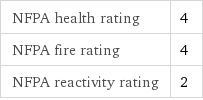
NFPA health rating | 4 NFPA fire rating | 4 NFPA reactivity rating | 2
Safety properties

autoignition point | 38 °C lower explosive limit | 1.8% (concentration in air)

DOT hazard class | 2.3 DOT numbers | 2199
Toxicity properties

short-term exposure limit | 0.4 mg/m^3

RTECS classes | agricultural chemical and pesticide | mutagen | human data